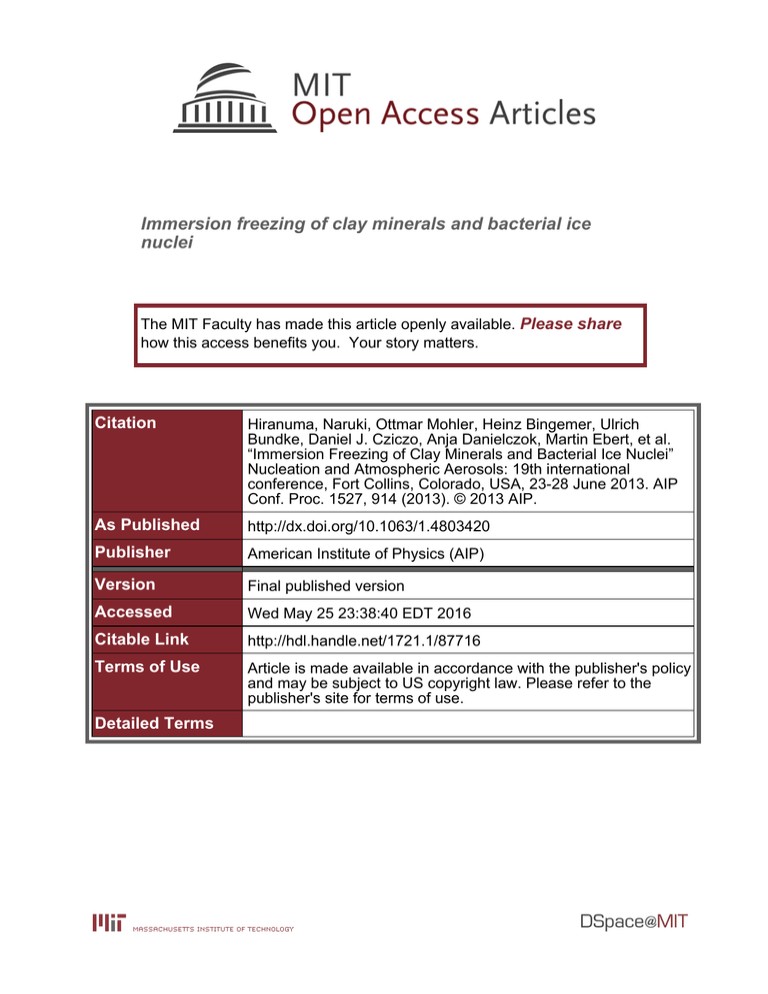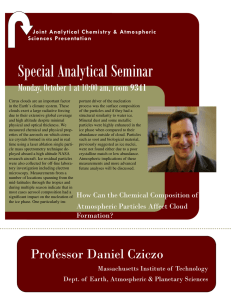Immersion freezing of clay minerals and bacterial ice nuclei Please share
advertisement

Immersion freezing of clay minerals and bacterial ice nuclei The MIT Faculty has made this article openly available. Please share how this access benefits you. Your story matters. Citation Hiranuma, Naruki, Ottmar Mohler, Heinz Bingemer, Ulrich Bundke, Daniel J. Cziczo, Anja Danielczok, Martin Ebert, et al. “Immersion Freezing of Clay Minerals and Bacterial Ice Nuclei” Nucleation and Atmospheric Aerosols: 19th international conference, Fort Collins, Colorado, USA, 23-28 June 2013. AIP Conf. Proc. 1527, 914 (2013). © 2013 AIP. As Published http://dx.doi.org/10.1063/1.4803420 Publisher American Institute of Physics (AIP) Version Final published version Accessed Wed May 25 23:38:40 EDT 2016 Citable Link http://hdl.handle.net/1721.1/87716 Terms of Use Article is made available in accordance with the publisher's policy and may be subject to US copyright law. Please refer to the publisher's site for terms of use. Detailed Terms Immersion freezing of clay minerals and bacterial ice nuclei Naruki Hiranuma, Ottmar Möhler, Heinz Bingemer, Ulrich Bundke, Daniel J. Cziczo, Anja Danielczok, Martin Ebert, Sarvesh Garimella, Nadine Hoffmann, Kristina Höhler, Zamin A. Kanji, Alexei Kiselev, Michael Raddatz, and Olaf Stetzer Citation: AIP Conference Proceedings 1527, 914 (2013); doi: 10.1063/1.4803420 View online: http://dx.doi.org/10.1063/1.4803420 View Table of Contents: http://scitation.aip.org/content/aip/proceeding/aipcp/1527?ver=pdfcov Published by the AIP Publishing Articles you may be interested in Radiolysis of alanine adsorbed in a clay mineral AIP Conf. Proc. 1544, 7 (2013); 10.1063/1.4813453 Clay Mineral: Radiological Characterization AIP Conf. Proc. 1034, 477 (2008); 10.1063/1.2991271 Immersion Cooler for Freezing Ice Mantles on TriplePointofWater Cells Rev. Sci. Instrum. 40, 376 (1969); 10.1063/1.1683953 Dielectric Loss of and Defects in Clay Minerals J. Chem. Phys. 27, 172 (1957); 10.1063/1.1743660 Adsorption Studies on Clay Minerals. I. Chromatography on Clays J. Chem. Phys. 20, 157 (1952); 10.1063/1.1700160 This article is copyrighted as indicated in the article. Reuse of AIP content is subject to the terms at: http://scitation.aip.org/termsconditions. Downloaded to IP: 18.7.29.240 On: Mon, 02 Jun 2014 14:13:50 Immersion Freezing of Clay Minerals and Bacterial Ice Nuclei Naruki Hiranumaa, Ottmar Möhlera, Heinz Bingemerb, Ulrich Bundkeb, Daniel J. Cziczoc, Anja Danielczokb, Martin Ebertd, Sarvesh Garimellac, Nadine Hoffmanna, Kristina Höhlera, Zamin A. Kanjie, Alexei Kiseleva, Michael Raddatzf, and Olaf Stetzere Institute for Meteorology and Climate Research – Atmospheric Aerosol Research, Karlsruhe Institute of Technology, Karlsruhe, Germany. b Institute for Atmospheric and Environmental Sciences, Goethe-University, Frankfurt/M, Germany. c Dept. of Earth, Atmospheric, and Planetary Sciences, Massachusetts Institute of Technology, Cambridge, USA. d Institute of Applied Geosciences, Technical University of Darmstadt, Darmstadt, Germany. e Institute for Atmospheric and Climate Science, ETH, Zurich, Switzerland. f Leibniz Institute for Tropospheric Research, Leipzig, Germany. a Abstract. The immersion mode ice nucleation efficiency of clay minerals and biological aerosols has been investigated using the AIDA (Aerosol Interaction and Dynamics in the Atmosphere) cloud chamber. Both monodisperse and polydisperse populations of (1) various clay dust samples as well as (2) Snomax® (a proxy for bacterial ice nucleators) and (3) hematite are examined in the temperature range between -4 C and -35 C. The temperature dependence of ice formation inferred by the INAS (Ice Nucleation Active Surface-Site) density is investigated and discussed as a function of cooling rate and by comparing to predicted nucleation rates (i.e., classical nucleation theory with -probability density function nucleation scheme). To date, we observe that maintaining constant AIDA temperature does not trigger any new ice formation during the immersion freezing experiments with clay dust samples and Snomax®, implying strong temperature dependency (and weak time dependency) within our time scales and conditions of experiments. Ice residuals collected through a newly developed PCVI (Pumped Counter-flow Virtual Impactor) with the 50% cut size diameter of 10 to 20 m have also been examined by electron microscope analyses to seek the chemical and physical identity of ice nuclei in clay minerals. In addition to the AIDA results, complementary measurements with mobile ice nucleation counters are also presented. Keywords: heterogeneous ice nucleation, immersion, clay mineral, biological aerosol, PCVI PACS: 42.68.Ge, 82.70.Rr, 64.60.Q-, 87.18.-h CLAY DUST SAMPLES The immersion freezing of various clay dust samples, including three illite (namely quartz rich illite from the Clay Mineral Society, feldspar rich German illite, and NX Nanopowder from Arginotec®) as well as two kaolinite standards (Fluka and Clay Mineral Society), has been studied in the temperature range -12 C to -35 C. The preliminary results are shown in FIGURE 1, where the INAS density, ns, represents the number concentration of ice crystals (Nice) normalized to the total surface area of Nucleation and Atmospheric Aerosols AIP Conf. Proc. 1527, 914-917 (2013); doi: 10.1063/1.4803420 © 2013 AIP Publishing LLC 978-0-7354-1152-4/$30.00 914 This article is copyrighted as indicated in the article. Reuse of AIP content is subject to the terms at: http://scitation.aip.org/termsconditions. Downloaded to IP: 18.7.29.240 On: Mon, 02 Jun 2014 14:13:50 particles (A). We observe the immersion mode ice nucleation activity, inferred by the INAS density, of clay minerals to be strongly dependent on the temperature. For instance, INAS density increases with decreasing temperature as previously described in the literature [e.g., 1, 2]. We also observe that the immersion mode nucleation of our dust samples is equally active as desert dust samples and even comparable to the deposition mode of Snomax®. Among our clay dust samples, kaolinite from Fluka is the most efficient immersion ice nuclei in the temperature range of -20 C to -28 C. An explanation of its ability to be more ice active compared to other clay minerals is given. FIGURE 1. INAS densities, ns, for deposition and immersion freezing of clay dust samples as a function of temperature, T. Lines represent fits to previously measured data of natural dusts (denoted as Dust) and Arizona Test Dust (ATD) taken from Niemand et al. [3], and references therein. SNOMAX SUSPENSION Snomax® (Johnson Controls Inc., Milwaukee, USA) is a commercially available product mainly composed of freeze-dried P. syringae bacteria and often used to induce artificial snow formation in ski resorts. As in previous studies, the particles generated from Snomax® solution/suspension (hereafter denoted as Snomax particles) trigger heterogeneous freezing in a narrow temperature range of -7 to -10 C, and associated the immersion mode ice nucleation efficiency of Snomax particles is well characterized [e.g., 4, 5, 6]. Even less studied to date is the freezing behavior of sizesegregated Snomax particles and its influence on overall freezing processes, including deposition, immersion, and contact mode. Given such a burden, for the first time, we conduct AIDA experiments with quasi-monodisperse Snomax particles for both deposition and immersion mode freezing. Results for the various expansions are plotted in FIGURE 2. The results indicate that while deposition mode ice nucleation of Snomax particles is nearly independent of size, immersion mode nucleation exhibits a strong size dependency (i.e., the larger surface carries more ice active protein complexes), suggesting a need for nucleation mode specific parameterization of size dependency. 915 This article is copyrighted as indicated in the article. Reuse of AIP content is subject to the terms at: http://scitation.aip.org/termsconditions. Downloaded to IP: 18.7.29.240 On: Mon, 02 Jun 2014 14:13:50 FIGURE 2. INAS densities, ns, for deposition and immersion freezing of Snomax particles as a function of temperature, T. HEMATITE AND THE EEFECT OF SURFACE MILLING The influence of surface modification of hematite on the ice nucleation efficiency and freezing mode has been diagnosed as a function of degree of milling and AIDA temperature (<-30 C). Milled hematite is generated by mechanically milling 800 nm diameter cubic hematite with 100 m diameter bronze beads for more than 6 hours (FIGURE 3). An isometric experiment is conducted on un-milled cubic hematite subset. We observe two trends as expansion conditions are varied. First, as opposed to the speculation in Möhler et al. [7], the surface modification does not substantially enhance the overall ability of ice nucleation, inferred by the INAS density. Second, early deposition mode ice nucleation before the spontaneous formation of droplets is routinely observed for the milled subset. Thus, the important conclusion is that the surface milling may alter nucleation mode, presumably bolstering size independent freezing. Conclusions from AIDA experiments are still ambiguous, and complementary analysis with an Electro-Dynamic Balance is briefly discussed. FIGURE 3. Size distributions of cubic and milled hematite. 916 This article is copyrighted as indicated in the article. Reuse of AIP content is subject to the terms at: http://scitation.aip.org/termsconditions. Downloaded to IP: 18.7.29.240 On: Mon, 02 Jun 2014 14:13:50 ACKNOWLEDGMENTS The authors gratefully acknowledge financial support provided by the Deutsche Forschungsgemeinshaft under the DFG research unit 1525 INUIT. The work of D. J. Cziczo and O. Stetzer was supported by EUROCHAMP2 under the Transnational Access Activity E2-2012-05-14-0075. K. Höhler acknowledges the HALO priority program 1294 under the DFG contract number MOEH 668/1-2. The expertise of G. Kulkarni for the PCVI work is gratefully acknowledged. REFERENCES 1. C. Hoose and O. Möhler, Heterogeneous ice nucleation on atmospheric aerosols: a review of results from laboratory experiments, Atmospheric Chemistry and Physics, 12, p9817- (2012). 2. B. Murray et al., Ice nucleation by particles immersed in supercooled cloud droplets. Chemical Society Reviews, 41, p6519- (2012). 3. M. Niemand et al., A Particle-Surface-Area-Based Parameterization of Immersion Freezing on Desert Dust Particles, Journal of the Atmospheric Sciences, 69, 10, p3077- (2012). 4. O. Möhler et al., Heterogeneous ice nucleation activity of bacteria: new laboratory experiments at simulated cloud conditions, Biogeoscience, 5, 1425–1435 (2008). 5. S. Hartmann et al., Immersion freezing of ice nucleating active protein complexes. Atmospheric Chemistry and Physics Discussions, 12, 21321–21353 (2012). 6. E. Attard et al., Effects of atmospheric conditions on ice nucleation activity of Pseudomonas. Atmospheric Chemistry and Physics, 12, 10667–10677 (2012). 7. O. Möhler et al., Efficiency of the deposition mode ice nucleation on mineral dust particles, Atmospheric Chemistry and Physics, 6, 3007–3021 (2006). 917 This article is copyrighted as indicated in the article. Reuse of AIP content is subject to the terms at: http://scitation.aip.org/termsconditions. Downloaded to IP: 18.7.29.240 On: Mon, 02 Jun 2014 14:13:50




